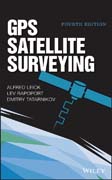
Employ the latest satellite positioning tech with this extensiveguide GPS Satellite Surveying is the classic text on thesubject, providing the most comprehensive coverage of globalnavigation satellite systems applications for surveying. Fullyupdated and expanded to reflect the field?s latest developments,this new edition contains new information on GNSS antennas, PrecisePoint Positioning, Real–time Relative Positioning, LatticeReduction, and much more. New contributors offer additional insightthat greatly expands the book?s reach, providing readers withcomplete, in–depth coverage of geodetic surveying using satellitetechnologies. The newest, most cutting–edge tools, technologies,and applications are explored in–depth to help readers stay up todate on best practices and preferred methods, giving them theunderstanding they need to consistently produce more reliablemeasurement.Global navigation satellite systems have an array of uses inmilitary, civilian, and commercial applications. In surveying, GNSSreceivers are used to position survey markers, buildings, and roadconstruction as accurately as possible with less room for humanerror. GPS Satellite Surveying provides complete guidancetoward the practical aspects of the field, helping readers to:Get up to speed on the latest GPS/GNSS developmentsUnderstand how satellite technology is applied tosurveyingExamine in–depth information on adjustments and geodesyLearn the fundamentals of positioning, lattice adjustment,antennas, and moreThe surveying field has seen quite an evolution of technology inthe decade since the last edition?s publication. This new editioncovers it all, bringing the reader deep inside the latest tools andtechniques being used on the job. Surveyors, engineers, geologists,and anyone looking to employ satellite positioning will find GPSSatellite Surveying to be of significant assistance. INDICE: PrefaceAcknowledgmentsAbbreviationsChapter 1 IntroductionChapter 2 Least–Squares Adjustments2.1 Elementary Considerations2.2 Stochastic and Mathematical Models2.3 Mixed Model2.4 Sequential Mixed Model2.5 Model Specifications2.6 Minimal and Inner Constraints2.7 Statistics in Least–Squares Adjustment2.8 Reliability2.9 Blunder Detection2.10 Examples2.11 Kalman FilteringChapter 3 Recursive Least Squares3.1 Static Parameter3.2 Static Parameters and Arbitrary Time–Varying Variables3.3 Dynamic Constraints3.4 Static Parameters and Dynamic Constraints3.5 Static Parameter, Parameters Subject to Dynamic Constraints,and Arbitrary Time–Varying ParametersChapter 4 Geodesy4.1 International Terrestrial Reference Frame4.2 International Celestial Reference System4.3 Datum4.4 3D Geodetic Model4.5 Ellipsoidal Model4.6 Conformal Mapping Model4.7 SummaryChapter 5 Satellite Systems5.1 Motion of Satellites5.2 GPS Global Positioning System5.3 GLONASS5.4 Galileo5.5 QZSS5.6 BeiDou5.7 IRNSS5.8 SBAS: WAAS, EGNOS, GAGAN, MSAS, and SDCMChapter 6 GNSS Positioning Approaches6.1 Observables6.2 Operational Details6.3 Navigation Solution6.4 Relative Positioning6.5 Ambiguity Fixing 6.6 Network–Supported Positioning6.7 Triple–Frequency Solutions6.8 SummaryChapter 7 Real–Time Kinematics Relative Positioning7.1 Multi–System Considerations7.2 Undifferenced and Across–Receiver Difference Observations7.3 Linearization and Hardware Bias Parameterization7.4 RTK Algorithm for Static and Short Baselines7.5 RTK Algorithm for Kinematic Rovers and Short Baselines7.6 RTK Algorithm with Dynamic Model and Short Baselines7.7 RTK Algorithm with Dynamic Model and Long Baselines7.8 RTK Algorithms with Changing Number of Signals7.9 Cycle Slip Detection and Isolation7.10 Across–Receiver Ambiguity Fixing7.11 Software ImplementationChapter 8 Troposphere and Ionosphere8.1 Overview8.2 Tropospheric Refraction and Delay8.3 Troposphere Absorption8.4 Ionospheric RefractionChapter 99.1 Elements of Electromagnetic Fields and ElectromagneticWaves9.2 Antenna Pattern and Gain9.3 Phase Center9.4 Diffraction and Multipath9.5 Transmission Lines9.6 Signal to Noise Ratio9.7 Antenna TypesAppendix A: General BackgroundA.1 Spherical TrigonometryA.2 Rotation MatricesA.3 Linear AlgebraA.4 LinearizationA.5 StatisticsAppendix B: The EllipsoidB.1 Geodetic Latitude, Longitude, and HeightB.2 Computation of the Ellipsoidal SurfaceAppendix C: Conformal MappingC.1 Conformal Mapping of PlanesC.2 Conformal Mapping of General SurfacesC.3 Isometric PlaneC.4 Popular Conformal MappingsAppendix D: Vector Calculus and Delta FunctionAppendix E: Electromagnetic Field generated by Arbitrary Sources,Magnetic Currents, Boundary Conditions, and ImagesAppendix F: Diffraction over Half–PlaneAppendix G: Single Cavity Mode Approximation with Patch AntennaAnalysisAppendix H: Patch Antennas with Artificial DielectricSubstratesAppendix I: Convex Patch Array Geodetic AntennaReferences
- ISBN: 978-1-118-67557-1
- Editorial: John Wiley & Sons
- Encuadernacion: Cartoné
- Páginas: 840
- Fecha Publicación: 25/03/2015
- Nº Volúmenes: 1
- Idioma: Inglés
